Today I cleared out a cupboard full of old teaching material (I know how to have fun!) I had accumulated files full of worksheets and little cut up cards I had made or photocopied years ago and inexplicably saved. I threw the vast majority out but found a couple of gems I haven’t seen for what must be 5 years or so.
One such gem was this storyboard:
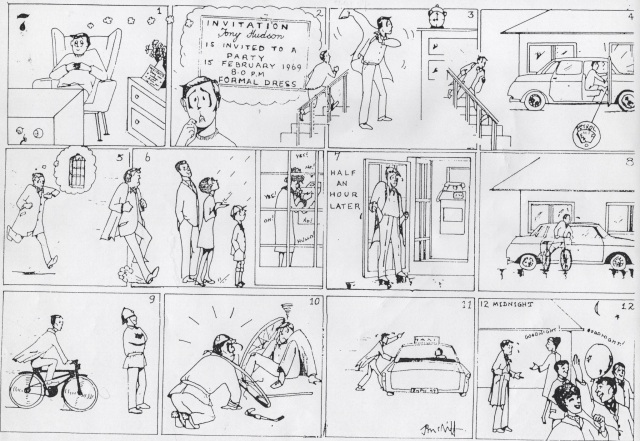 I’m afraid I have no recollection of the source, so if anyone recognises it, please help me reference it appropriately. It must be pretty old as the invitation in picture 2 says 1969!
I’m afraid I have no recollection of the source, so if anyone recognises it, please help me reference it appropriately. It must be pretty old as the invitation in picture 2 says 1969!At first I couldn’t remember what on earth I had used it for in class, in fact it got me thinking about other things you could use this story for.
Stories have great potential in the language classroom; the value of storytelling is neatly summed up by Andrew Wright here. In this post however, I want to look at using stories as a way of presenting new language, rather than the art of storytelling itself.
A Contextual Vehicle
I’m a fan of using short stories and anecdotes as contextual vehicles for presenting language. There are so many language points you can draw out from a story to focus on and present grammar or vocabulary. With a storyboard, the pictures provide a very visual representation of meaning to work on with the students. Below are 3 possible language points for the storyboard above.
Narrative Tenses
Most stories have a number of different time references so an obvious language point to highlight when using a story is narrative tenses. A teacher could elicit or highlight these tenses from the context of the story. For example:
Pic 1 – Tony was relaxing at home when he suddenly remembered he had been invited to a party.
Past continuous (background events), past simple and past perfect (passive) all in one picture.
 Pic 3 – He ran upstairs, put on his suit and ran downstairs.
Pic 3 – He ran upstairs, put on his suit and ran downstairs.
Past simple (events in chronological order).
Pic 4 – He tried to start his car but it had run out of petrol.
Past simple and past perfect.
 Pic 6 – When he got to the phone box, a woman was chatting and it was raining.
Pic 6 – When he got to the phone box, a woman was chatting and it was raining.
Past simple and past continuous (actions in progress).
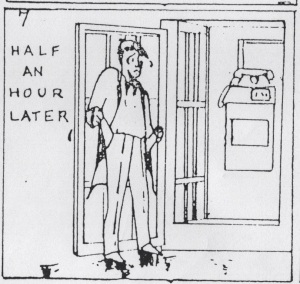 Pic 7 – He realised he hadn’t taken any money with him.
Pic 7 – He realised he hadn’t taken any money with him.
Past simple and past perfect.
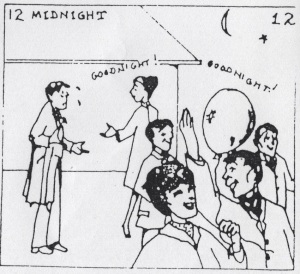 Pic 12 – When he finally arrived, his friends were leaving and the party had finished.
Pic 12 – When he finally arrived, his friends were leaving and the party had finished.
Past simple, past continuous and past perfect.
You could probably squeeze in some past perfect continuous too (He‘d been looking forward to going to the party for ages).
Phrasal verbs
I originally used the story as a presentation for phrasal verbs, at an intermediate level if I remember rightly. The story could contain a number of phrasal verbs; of course the choice and complexity of the story is dependent on level.
Phrasal verbs that could be drawn out of this story:
Pic 1 – sit down, chill out, put (feet) up, stay in, not go out
Pic 2 – look forward to (going to the party)
Pic 3 – put on (his suit), go out
Pic 4 – get in (the car), run out of (petrol)
Pic 5 – come up with (an idea)
Pic 6 – queue up
Pic 7 – run out of (money/coins)
Pic 8 – get on (his bicycle)
Pic 9 – (He shouted) ‘Look out!’
Pic 10 – crash into (a policeman), fall off (his bike)
Pic 11 – get in (a taxi)
Pic 12 – turn up (to the party)
Expressions with get
Similarly, the lesson could focus on uses of get. There are many possible examples to draw out of the story:
Pic 1 – get home from work
Pic 3 – get changed
Pic 4 – get in (his car), get angry
Pic 6 – get to the phonebox, get angry
Pic 7 – get worse
Pic 8 – get on (his bike)
Pic 10 – get into trouble
Pic 11 – get a taxi
Pic 12 – get to the party
A possible procedure for this type of lesson:
Here’s what I would generally do with this kind of presentation.
1. T leads into topic (in this case, being late). T could ask learners to think about the last time they were late for something; they could brainstorm the worst things to be late for, or they could have some discussion questions about punctuality.
2. T tells class he/she is going to tell them a story about a time when the T/friend of T was late (more fun if it is personalised).
3. T gives ss picture cut up (remembering to cut off or tippex out the little numbers in the corners!), and asks learners to put the pictures into a logical order.
4. T tells story and learners listen and check their order.
5. T elicits story from the learners picture by picture, eliciting or feeding in the target language, concept checking and drilling as necessary. (A large version of the storyboard on the whiteboard or IWB helps here to get everyone focussed.
6. As story builds up T keeps returning to the beginning of the story and re-eliciting it, paying particular attention to the target language, perhaps asking students to tell the story in a chain, with each student talking about one picture each. T insists on accuracy at this stage.
7. Once T is confident learners have the story, T hands over to students to practise telling the story in pairs. T monitors and helps where necessary.
8. As an extra challenge, T could then remove the story and students have to remember it all.
9. Follow up controlled and freer practice of the language point.
10. Follow up task (E.g. Students create their own story using the language).
Advantages of using a storyboard to present language
- Pictures give a strong visual representation of meaning; they are efficient and much clearer than wordy definitions.
- Stories are engaging and memorable for the students.
- The storyboard allows the teacher to go back to the beginning, repeating, recycling and reinforcing the language.
- This kind of approach involves lots of opportunity for eliciting language and getting the learners working together.
- The meaning of new language is clear from the context.
- Meaning comes first when eliciting.
Perhaps you could find some other things to use this storyboard for. Any suggestions welcome in the comments below.
Now back to that cupboard…

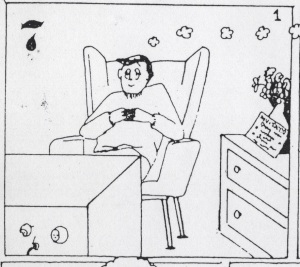
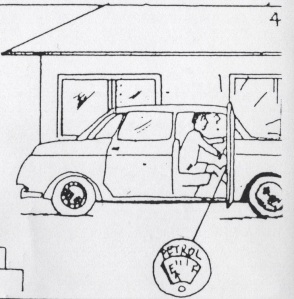







Action English Pictures Alemany Press Perhaps??
LikeLike
Pingback: A story out of context | TeachingEnglish | Sco...
Isn’t it great how much language you can generate from pictures like these? My only suggestion is that you do go back to the cupboard and find any more that you have!
LikeLike
Hi Andrew. Thanks for your comment. I’ll have another root around!
LikeLike
Pingback: A story out of context | Professional Developme...
I’m about to teach elementary and pre-int for the first time in ages and I just resurrected my stories to practise past simple – Shirley valentine from Reward pre-int and poor fabio from reward elementary. I do very similar lesson to the one you suggest above.
LikeLiked by 1 person
Funny you should mention ‘Poor Fabio’. It is one of my most favourite lessons! I use it all the time. In fact, I adapted it for my final externally observed Delta lesson focussing on pronunciation of -ed endings, which went down well. Will have to check out the Shirley Valentine lesson you mentioned. Good luck with your new courses!
LikeLike
Pingback: A story out of context | useful ESL sites in ly...
Pingback: A story out of context | Esl | Scoop.it
I’ve used “picture story 7” many, many times. It’s wonderful for teaching phrasal verbs etc, just as you pointed out. I also have a copy of “picture story 8” about the same man getting fired from a job. I’ve been trying to identify the source for years now. It would be great to have more of these great stories. If anybody knows the book they come from, please, let us know:)
LikeLike